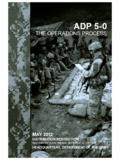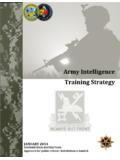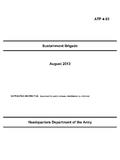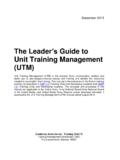Transcription of ADP 6-0 03 May 2012
1 DISTRIBUTION RESTRICTION: Approved for public release; distribution is , DEPARTMENT OF THE ARMYMAY 2012 MISSION COMMANDADP 6-0 This publication is available at Army Knowledge Online ( ). *ADP 6-0 (FM 6-0) DISTRIBUTION RESTRICTION. Approved for public release; distribution is unlimited. *This publication supersedes FM 6-0, dated 13 September 2011. i Army Doctrine Publication No. 6-0 Headquarters Department of the Army Washington, DC, 17 May 2012 Mission Command Contents Page PREFACE .. ii unified land operations and Mission Command .. 1 The Army s Approach to Mission Command .. 1 The Mission Command Philosophy of Command .. 5 The Mission Command Warfighting Function .. 9 Conclusion .. 12 GLOSSARY .. Glossary-1 REFERENCES.
2 References-1 Figure Figure 1. The exercise of mission command .. iv ii ADP 6-0 17 May 2012 Preface Army Doctrine Publication (ADP) 6-0 presents the Army s guidance on command, control, and the mission command warfighting function. This publication concisely describes how commanders, supported by their staffs, combine the art of command and the science of control to understand situations, make decisions, direct action, and accomplish missions. (See figure 1, page iv, for a graphical overview of the exercise of mission command.) The principal audience for ADP 6-0 is all professionals within the Army. Commanders and staffs of Army headquarters serving as joint task force or multinational headquarters should also refer to applicable joint or multinational doctrine on command and control of joint or multinational forces. Trainers and educators throughout the Army will also use this publication.
3 Commanders, staffs, and subordinates ensure their decisions and actions comply with applicable , international, and, in some cases, host-nation laws and regulations. Commanders at all levels ensure their Soldiers operate in accordance with the law of war and the rules of engagement. (See Field Manual [FM] 27-10.) To understand and apply mission command doctrine, readers must understand how unified land operations (the Army s operational concept, described in ADP 3-0, unified land operations ) contributes to unified action. In addition, readers must be familiar with the fundamentals of the operations process, established in ADP 5-0, The operations Process, and the fundamentals of Army leadership. Army Doctrine Reference Publication (ADRP) 6-0, also titled Mission Command, explains the principles of mission command in more detail.
4 Taken as a whole, the doctrine in ADP 6-0, ADRP 6-0, and ADP 5-0 forms the foundation for the tactics, techniques, and procedures for the exercise of mission command. ADP 6-0 uses joint terms where applicable. Selected joint and Army terms and definitions appear in both the glossary and the text. Terms for which ADP 6-0 is the proponent publication (the authority) are marked with an asterisk (*) in the glossary. Definitions for which ADP 6-0 is the proponent publication are boldfaced in the text. These terms and their definitions will be in the next revision of FM 1-02. For other definitions shown in the text, the term is italicized and the number of the proponent publication follows the definition. ADP 6-0 applies to the Active Army, Army National Guard/Army National Guard of the United States, and United States Army Reserve unless otherwise stated.
5 The proponent of ADP 6-0 is the United States Army Combined Arms Center. The preparing agency is the Combined Arms Doctrine Directorate, United States Army Combined Arms Center. Send comments and recommendations on a DA Form 2028 (Recommended Changes to Publications and Blank Forms) to Commander, Army Mission Command 17 May 2012 ADP 6-0 iii Combined Arms Center and Fort Leavenworth, ATTN: ATZL-MCK-D (ADP 6-0), 300 McPherson Avenue, Fort Leavenworth, KS 66027-2337; by e-mail to or submit an electronic DA Form 2028. ADP 6-0 iv ADP 6-0 17 May 2012 Figure 1. The exercise of mission command 17 May 2012 ADP 6-0 1 This publication begins by introducing the mission command philosophy of command as a foundation of unified land operations .
6 It then discusses the Army s approach to mission command. Next, it explains how Army commanders apply the mission command philosophy to balance the art of command and the science of control. Finally, it explains the mission command warfighting function. unified land operations AND MISSION COMMAND 1. unified land operations is the Army s operational concept. This concept is based on the central idea that Army units seize, retain, and exploit the initiative to gain a position of relative advantage over the enemy. This is accomplished through decisive action the simultaneous combination of offensive, defensive, and stability operations (or defense support of civil authorities) that set the conditions for favorable conflict resolution. 2. The mission command philosophy of command is one of the foundations of unified land operations .
7 Mission command is the exercise of authority and direction by the commander using mission orders to enable disciplined initiative within the commander s intent to empower agile and adaptive leaders in the conduct of unified land operations . The mission command philosophy effectively accounts for the nature of military operations . Throughout operations , unexpected opportunities and threats rapidly present themselves. operations require responsibility and decisionmaking at the point of action. Through mission command, commanders initiate and integrate all military functions and actions toward a common goal mission accomplishment. THE ARMY S APPROACH TO MISSION COMMAND 3. An effective approach to mission command must be comprehensive, without being rigid, because military operations as a whole defy orderly, efficient, and precise control.
8 Military operations are complex, human endeavors characterized by the continuous, mutual give and take, moves, and countermoves among all participants. The enemy is not an inanimate object to be acted upon. It has its own objectives. While friendly forces try to impose their will on the enemy, the enemy resists and seeks to impose its will on friendly forces. In addition, operations occur among civilian groups whose actions influence and are influenced by military operations . The results of these interactions are often unpredictable and perhaps uncontrollable. A HUMAN SOLUTION TO COMPLEX OPERATIONAL CHALLENGES 4. To overcome these challenges, mission command doctrine incorporates three ideas: the exercise of mission command, the mission command philosophy, and the mission command warfighting function.
9 In this discussion, the exercise of mission command refers to an overarching idea that unifies the mission command philosophy of command and the mission command warfighting function a flexible grouping of tasks and ADP 6-0 2 ADP 6-0 17 May 2012 systems. The exercise of mission command encompasses how Army commanders apply the foundational mission command philosophy together with the mission command warfighting function. The principles of mission command guide commanders and staffs in the exercise of mission command. THE PRINCIPLES OF MISSION COMMAND 5. The exercise of mission command is based on mutual trust, shared understanding, and purpose. Commanders understand that some decisions must be made quickly at the point of action. Therefore, they concentrate on the objectives of an operation, not how to achieve it.
10 Commanders provide subordinates with their intent, the purpose of the operation, the key tasks, the desired end state, and resources. Subordinates then exercise disciplined initiative to respond to unanticipated problems. Every Soldier must be prepared to assume responsibility, maintain unity of effort, take prudent action, and act resourcefully within the commander s intent. 6. Effective commanders understand that their leadership guides the development of teams and helps to establish mutual trust and shared understanding throughout the force. Commanders allocate resources and provide a clear intent that guides subordinates actions while promoting freedom of action and initiative. Subordinates, by understanding the commander s intent and the overall common objective, are then able to adapt to rapidly changing situations and exploit fleeting opportunities.













